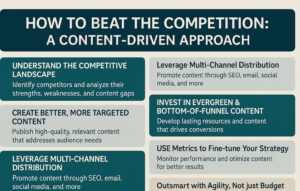In today’s saturated digital marketplace, it’s not enough to simply have a good product or service. Your competition is fierce, and they’re just a click away. So, how do you stand out? How do you beat the competition without racing to the bottom on price or burning out chasing trends?
The answer lies in a smart, consistent, and strategic use of content.
This article will walk you through how to use content to differentiate your brand, build authority, and convert your audience—so your business doesn’t just survive the competition, it supersedes it.
Need help with content creation? Our expert writers have experience crafting all sorts of written content that ranks—generating organic traffic and giving you a leg-up on your competition. Click below to explore what we offer.
1. Understand the Competitive Landscape
Before you can outrank, outshine, or out-convert your competitors, you need to know who they are and what they’re doing.
Start with research:
- Google your own keywords: Who ranks on page 1? What are their headlines and content angles?
- Use tools like Ahrefs, Semrush, or Ubersuggest to analyze competitors’ domain authority, top-performing content, and backlink profiles.
- Follow their social media and newsletters to track their messaging and tone.
What to look for:
- What they’re doing well (design, clarity, offers)
- Where they’re falling short (outdated blogs, poor UX, generic tone)
- What gaps exist in the market (underserved niches, unanswered questions)
This groundwork gives you a blueprint to differentiate and dominate—by not just copying what works, but improving it.
2. Define Your Unique Brand Positioning
Once you understand the competitive field, it’s time to define your edge.
Ask yourself:
- What do we do differently?
- Why do our customers choose us?
- What’s our tone—fun and bold, or expert and data-driven?
Positioning isn’t just about what you sell—it’s how you frame it.
For example:
- A business coach might position themselves as “relaxed, anti-hustle” to stand out in a sea of hyper-masculine, grind-culture brands.
- A skincare brand might focus on “radical transparency” and ingredient education to gain trust in a crowded industry.
Your content should reflect and reinforce this positioning at every touchpoint—from headlines and blog intros to CTAs and testimonials.
3. Create Better, More Targeted Content
“Better content” doesn’t mean higher word counts. It means more relevant, helpful, and aligned with your audience’s intent, while offering some form of unique insight.
Here’s how:
- Use keyword research tools to find what your audience is actively searching for.
- Go deeper or more specific than competitors. Instead of “Email Marketing Tips,” try “Email Marketing Tips for Coaches Selling High-Ticket Programs.”
- Answer questions more thoroughly, offer frameworks, include visuals, and cite data.
- Add original angles: Interviews, personal stories, or industry commentary add authority and freshness.
📌 Pro Tip: Skyscraper content (taking an existing piece and improving it) still works in 2025—but only if it’s genuinely better.
4. Use Content to Build Authority and Trust
Trust is the currency of online business. When people trust your brand, they’re more likely to buy, refer, and stick around.
Here’s how to earn that trust:
Educational Content
- Publish “how-to” guides, tutorials, and explainers
- Break complex topics into simple, actionable steps
- Use storytelling and real-world examples to make your advice relatable
Case Studies and Testimonials
- Show your method in action
- Highlight client transformations
- Use visuals or data to back up claims
Visibility Through Thought Leadership
- Pitch guest posts on relevant industry blogs
- Be a guest on podcasts or webinars
- Collaborate with complementary brands
Becoming the go-to source in your niche builds staying power—competitors can’t copy trust.
5. Leverage Multi-Channel Distribution
Content alone isn’t enough—you need to distribute it where your audience is spending time.
Here’s how to stretch one piece of content:
- Blog post → Instagram carousel → LinkedIn thought piece → Email summary
- Webinar → Video clips → YouTube highlights → Podcast episode → Slide deck
Use a mix of owned channels (email list, website), earned media (guest features, shares), and social media (LinkedIn, TikTok, Instagram, Pinterest).
Repurposing multiplies your reach without multiplying your workload.
6. Invest in Evergreen & Bottom-of-Funnel Content
Trending topics might spike traffic—but evergreen content sustains it.
Create content that continues to deliver:
- Ultimate guides on core services or products
- Resource hubs for your industry (e.g., “Everything You Need to Launch a Coaching Business”)
- Product comparison pages or FAQs that address purchase objections
- Bottom-of-funnel (BOFU) content like pricing pages, service breakdowns, and demo walkthroughs
BOFU content attracts people who are already considering a purchase. It’s where buying decisions are made.
7. Track, Test, and Tweak What Works
Your content strategy shouldn’t be set in stone. The best brands iterate constantly.
Track these key metrics:
- Traffic & bounce rate (Google Analytics 4)
- Keyword rankings (Search Console, Ahrefs)
- Conversions (forms filled, purchases made)
- Scroll depth & heatmaps (Hotjar, Microsoft Clarity)
Then test:
- Different headlines
- Content formats (text vs. video vs. carousel)
- Calls to action and opt-in placements
Even small changes—like rewording a headline or embedding a video—can lead to big conversion lifts.
8. Outsmart with Agility, Not Just Budget
You don’t need to outspend competitors—you need to outmaneuver them.
Advantages small businesses have over big brands:
- Speed: Launch a blog post or campaign in hours, not weeks
- Personality: Speak directly to your audience in a way big brands can’t
- Relevance: Tap into trending topics or niche conversations quickly
- Feedback loops: Use audience responses to shape your next post, product, or freebie
While larger competitors may have more resources, your agility is your edge.
9. Bonus: Avoid Common Content Mistakes
To truly beat the competition, avoid these traps:
- Creating content without a strategy (guessing ≠ growing)
- Focusing only on top-of-funnel traffic with no plan to convert
- Publishing once, then moving on instead of updating and repurposing
- Ignoring your audience’s voice and using generic “bro-marketing” tone
Consistency, clarity, and connection always win in the long game.
To Conclude: Your Content Is Your Competitive Edge

If your business is struggling to stand out, content isn’t just a marketing tool—it’s your sharpest weapon.
Done right, content:
- Builds visibility and trust
- Clarifies your brand’s value
- Converts cold leads into loyal customers
- Keeps competitors chasing you
But beating the competition doesn’t happen overnight. It takes intentional planning, consistent action, and a content strategy designed to outsmart, not outspend.
🎯 Action Steps
- Identify 3 top competitors and analyze their content strategy.
- Define your unique brand angle and content voice.
- Plan one pillar blog post targeting a key audience problem.
- Distribute and repurpose it across 2–3 platforms.
- Track results and refine for your next post.
Need Content But Not Sure Where to Look?
Our top writers have experience creating content that converts, at scale. We’ll work with you to achieve your business goals.
FAQ
Q: How long does it take to beat my competitors with content?
A: Most businesses start seeing SEO and content traction in 3–6 months, but you’ll build brand trust and engagement from week one with consistency.
Q: What if my competitors already dominate search rankings?
A: Find content gaps they haven’t addressed, serve underserved audiences, or add depth, visuals, or unique angles to outperform them.
Q: Should I copy what my competitors are doing?
A: Learn from them—but never copy. Your competitive edge comes from offering something better, clearer, or more aligned with your audience.




